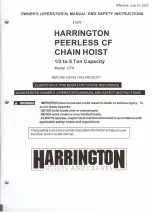
www.tigerlifting.com
Unit 1, Greensfield Industrial Estate,
Willowburn Avenue,
ALNWICK, NE66 2DG
Email: [email protected]
www.tigerlifting.com
Page 10 of 38
Manual Tiger SS11-PLH En 201704 v3.2
As well as following any industry or country specific guidance on lever hoists used at an angle to the vertical, we recommend
that before commencing an operation using multiple hoists or involving the transfer of a load from one hoist to another, the
following is adhered too:
All the units that are to be used in such an operation must be of the same make and model and have the same rated
capacity.
Attachment points are critical and the suspension point must have a rated capacity equal to or greater than that of
the load to be lifted at the angle that the load will be a carried through.
The attachment points must be designed and certified to work at angles away from the vertical.
The attachment points must be the correct size to allow the hooks to attach correctly in the bowl of the hook and
have enough clearance to allow the hook room to articulate.
All fleeting operations should be risk assessed by a competent person.
Load calculations and method statements should be produced.
Proximity hazards should be accounted for.
The load chain should be kept free of any twists and must enter the hoist body in a straight line over the load sheave.
Care should be taken on multi fall hoists to ensure the bottom hook is not is capsized/rolled over (i.e. bottom hook
has looped through the multi fall chain) which results in the chain becoming twisted.
When taking up the load or beginning the transfer between hoists particular care should be taken to align the hoist
body so that the body, load chain and top and bottom hooks are all in line.
The top and bottom hooks should be free to rotate within the hook yoke and cannot become trapped or jammed
causing stress areas in both the hook and the body.






























